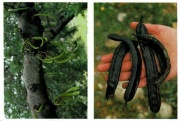Difference between revisions of "Carob"
Jump to navigation
Jump to search
m (Text replace - "== Authority ==" to "== Sources Checked for Data in Record ==") |
|||
| Line 8: | Line 8: | ||
''Ceratonia siliqua''; caroubier (Fr.); algarrobo (Esp.); alfarrobeira (Port.); carrubo (It.); locust; St. John's Bread | ''Ceratonia siliqua''; caroubier (Fr.); algarrobo (Esp.); alfarrobeira (Port.); carrubo (It.); locust; St. John's Bread | ||
| − | == | + | ==Physical and Chemical Properties== |
Pods = 7.5-30 centimeters long | Pods = 7.5-30 centimeters long | ||
| − | == | + | ==Resources and Citations== |
| − | * ''Encyclopedia Britannica'', http://www.britannica.com Comment: Carob. Retrieved May 25, 2003 | + | * ''Encyclopedia Britannica'', http://www.britannica.com Comment: Carob. Retrieved May 25, 2003. |
* ''Ancient Egyptian Materials and Technologies'', Paul Nicholson, Ian Shaw (eds.), Cambridge University Press, Cambridge, 2000 Comment: R.Gale, P.Gasson, N.Hepper, G.Killen, "Wood", p. 334-371. | * ''Ancient Egyptian Materials and Technologies'', Paul Nicholson, Ian Shaw (eds.), Cambridge University Press, Cambridge, 2000 Comment: R.Gale, P.Gasson, N.Hepper, G.Killen, "Wood", p. 334-371. | ||
Latest revision as of 15:01, 20 May 2022
Description
A small evergreen tree, Ceratonia siliqua, native to the Mediterranean region. Carob trees produce large seed pods which contain high amounts of an edible carbohydrate mucilage called Locust bean gum. The wood is hard and strong. Carob wood was used for furniture and cabinets.
Synonyms and Related Terms
Ceratonia siliqua; caroubier (Fr.); algarrobo (Esp.); alfarrobeira (Port.); carrubo (It.); locust; St. John's Bread
Physical and Chemical Properties
Pods = 7.5-30 centimeters long
Resources and Citations
- Encyclopedia Britannica, http://www.britannica.com Comment: Carob. Retrieved May 25, 2003.
- Ancient Egyptian Materials and Technologies, Paul Nicholson, Ian Shaw (eds.), Cambridge University Press, Cambridge, 2000 Comment: R.Gale, P.Gasson, N.Hepper, G.Killen, "Wood", p. 334-371.
